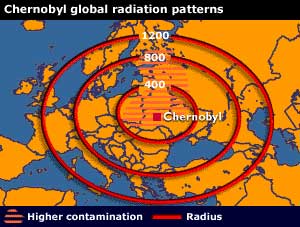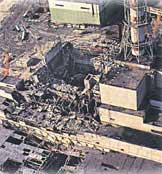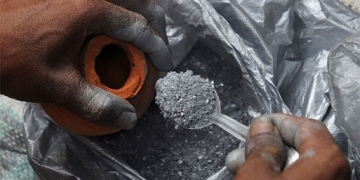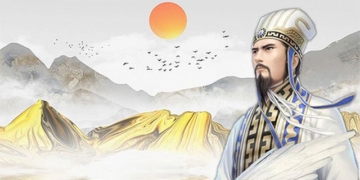At 1:23 AM on April 26, 1986, at the Chernobyl Nuclear Power Plant, located in the Ukrainian Republic of the former Soviet Union, an unprecedented accident occurred in the history of the global nuclear energy sector.
Dr. El Baradei, Director General of the International Atomic Energy Agency (IAEA), referred to this as “a disaster but also a significant turning point for the IAEA.” It shook the world’s confidence in the safety of nuclear energy, a vast source of clean energy that humanity hoped would eliminate concerns about energy shortages forever.
 |
|||
|
The affected area of the Chernobyl disaster, with the dashed lines indicating regions of high radiation contamination. (Photo: Ki4u.com) Before 1986, few ordinary people thought a nuclear accident could occur. There was a strong belief in science and the perfect responsibility of experts in this advanced field. However, today, Chernobyl has become a household name. The media writes extensively and controversially about it, creating heavy psychological pressure on residents who once lived near the site of the disaster, on those in other countries with nuclear power plants, and even on energy policy makers in various nations. The situation became so serious that in 2004, 18 years after the accident, the United Nations held an international workshop with the participation of the International Atomic Energy Agency (IAEA) and all relevant agencies, along with representatives from Russia, Ukraine, and Belarus, to sift through all the information, distinguish truth from falsehood, and provide a summary to the General Assembly. This international forum aimed to “provide responsible and truthful information about the post-Chernobyl reality,” helping to differentiate fabricated news that proliferates in today’s information explosion. Yet, even within expert circles, assessments of the scope and severity of this disaster vary significantly. How Did the Accident Occur? Even a brief presentation of the events and causes of the Chernobyl accident is difficult to write and read, as it involves many concepts and terms that are not widely known. In simple terms, the Chernobyl nuclear power plant was equipped with a type of reactor that was the first designed in the Soviet Union, based on the development of plutonium-producing reactors for military purposes. The design of this reactor type harbored several dangers. A clear analogy is that a ball at the bottom of a deep hole is in a state of stable equilibrium; if any force causes it to move, it will roll back to its original position. Western nuclear reactors are designed such that safety adjustments can occur naturally, similar to the ball rolling back to the bottom of the hole if displaced. This design principle creates the inherent safety factor of the reactor. As early as the 1970s, many experts pointed out that the reactor type at Chernobyl lacked this critical safety factor. However, the Soviet Union’s nuclear safety regulations did not ensure that reactors built must have this inherent safety feature, remain stable at different power levels, and adhere to the principle of “defense in depth” to prevent accidents. Worse yet, there was no containment structure at Chernobyl, a key element of the “defense in depth” strategy, which would contain radioactive materials in case of a reactor breach. However, design flaws merely served as potential risks. It was human negligence in disregarding safety regulations that turned these risks into reality. Following the Chernobyl disaster, the term “safety culture” emerged, and building this culture is regarded by the IAEA as a particularly important task for countries with or planning to have nuclear power. At that time, there was a desire to conduct an experiment while the reactor was operating at a very low power level (compared to its nominal capacity). As the reactor was unstable at low power levels, the automatic shutdown system would activate to prevent accidents. To proceed with the experiment, a reckless and deadly decision was made to disable the automatic shutdown system, disregarding safety culture. As a result, when the reactor’s power increased rapidly, due to instability at low power levels, it could not be returned to a safe state. The power surged to a level where water, the heat transfer medium, could not cool efficiently and began to boil violently. A significant steam explosion shattered the approximately 1000-ton cover of the reactor and part of the reactor building. At high temperatures, steam decomposed or was reduced to create hydrogen gas. Without the containment structure, air from outside rushed in, causing a hydrogen explosion and igniting thousands of tons of graphite moderator for ten horrifying days and nights, with temperatures soaring to 2000°C. It was not a nuclear explosion but purely a steam and chemical explosion; however, without a containment structure, the amount of radiation released was approximately 100 to 400 times greater than that of the atomic bomb dropped on Hiroshima, propelled into the atmosphere by the chemical explosion and burning graphite. This deadly dust cloud was carried by winds to the North, reaching distances of up to 500 km, leaving consequences that persist to this day. How Many People Died in the Chernobyl Disaster? But that’s not all. By 2004, at least 1,800 cases of children aged 0 to 14 at the time of the accident were recorded as having thyroid cancer. This is a significantly higher rate than normal, as children’s thyroids are more susceptible to radioactive iodine, which is a cancer-inducing agent. Fortunately, no increase in other forms of cancer has been detected, even among those who worked on the aftermath of the disaster. How Wide is the Contaminated Area? Some reports suggest that only about 18,000 square kilometers of agricultural land were contaminated and deemed unsuitable for farming, along with approximately 35,000 square kilometers of forest affected by radioactive materials. However, many experts and environmental organizations assert that up to 150,000 square kilometers in Belarus, Russia, and Ukraine—almost half the area of Vietnam—were contaminated. The land within a 30 km radius of the plant, roughly three times the area of Hanoi, is considered a forbidden zone. Numerous mutations in flora and fauna have occurred following the accident. Some trees have altered shapes, and many animals born are deformed. How Are the Aftermath of the Accident Being Addressed? There are no accurate figures regarding the forces involved in addressing the aftermath of the accident. Russia reported nearly 400,000 people participated in this challenging work, along with approximately 600,000 others involved in related activities. They dismantled the debris, constructed waste storage facilities, dams, water filtration systems, and cleaned up the plant and surrounding areas. Using the “long arm” method, they constructed a massive sarcophagus to entomb reactor number 4, preventing further radioactive release. However, today, this massive concrete structure has begun to crack, requiring intervention to prevent radioactive leakage and other incidents. The hastily erected radioactive tomb at the time of the disaster is vastly different from the standards for burying spent fuel. Used fuel rods, if not recycled, must be buried deep in waste storage facilities approximately five hundred meters underground, at locations with suitable geological and hydrological conditions, alongside multiple enduring barriers designed to last tens of thousands of years. The use of contaminated land for agriculture has required significant international support. Scientists from advanced nations have focused on cultivating plants capable of concentrating radioactive materials in their stems, branches, leaves, and skins, while the seeds remain free of contamination, thus retaining economic value. For example, the Food and Agriculture Organization (FAO) has provided techniques for separating cesium from milk and meat. The FAO also assisted Belarus in choosing to cultivate rapeseed on contaminated land. The radioactive material concentrates in the stems and pods of this plant, while the seeds remain uncontaminated, allowing rapeseed oil to be used as food. However, nothing can heal the pain of the hundreds of thousands of people forced to leave their familiar villages. No one can reassure the millions who lived in the accident zone or participated in the cleanup, who are always haunted by the worry that one unfortunate day, illness will manifest in them or their children. Some have resorted to suicide out of despair. Many couples hesitate to have children for fear of giving birth to deformed offspring. Humanity’s faith in nuclear energy will likely take a long time to recover. What is Chernobyl Like Now?
When the disaster occurred, there were 200 tons of uranium fuel in reactor number 4. Estimates of the amount of uranium released during the disaster vary significantly. Ukrainian authorities assert that their studies over the past 15 years indicate that 95% of the uranium fuel remained in the reactor after the explosion. Many others estimate that the amount of fuel released ranged from 3% to 20%. However, in 2002, two renowned physicists, Konstantin Checherov from the Kurchatov Institute in Moscow and Sebastian Pflugbeil, Director of the Berlin Radiation Protection Agency, announced on German National Television (ZDF) that most of the fuel had escaped from the reactor, with only a negligible amount remaining. Regardless of the estimates, over 100 radioactive elements were released into the atmosphere, amounting to about 1/1000 to 1/100 of the radioactive dust produced by nuclear weapons tests in the 1960s and 70s. Most of these elements have short lifespans and quickly disappear. However, Strontium-90 and Cesium-137 have half-lives of 29 years and 30 years, respectively, meaning that after 29 and 30 years, their radioactivity has only decreased by half and remains hazardous even today and for many decades to come. Surprisingly, despite the high levels of radiation, many rare animal species have returned to the exclusion zone in large numbers, including beavers, elk, wild boars, wolves, carnivorous mammals, and numerous bird species. The dams built by beaver families have raised water levels, expanded wetlands, and enriched aquatic life. Forests are encroaching on old pastures and villages. Some residents, particularly the elderly, unable to bear the pain of displacement and nostalgia for their memories, have returned to the exclusion zone. However, there are no schools for children in this area to avoid the effects of radiation on young people. Tourists have also been allowed to visit the site of the accident. Final Words Some other scientists have “wisely” advised policymakers to adopt a “wait and see” strategy, the essence of which is to refrain from drawing any specific conclusions about the choice of future energy sources, postponing the day of considering nuclear power as much as possible while waiting for the emergence of new generations of reactors with advanced technologies. The reasoning behind this is indeed compelling. However, the primary cause of the 1986 disaster seems not to have been the inadequacy of nuclear technology at the time but rather the regulations and the people involved. It is believed that a strong rule-of-law state requires three elements: Laws must be theoretically affirmed and demonstrated by reality as supreme; Laws must be perfectly constructed, meaning they must be comprehensive, accurate, feasible, non-contradictory, and clear; And the populace must have a habit of adhering to the law. Chernobyl occurred due to lax safety regulations that allowed poorly designed reactors to be built, and operators disregarded regulations, thus lacking at least two of the three aforementioned elements. It should also be noted that in 1983, just three years before the Chernobyl disaster, a similar incident occurred at a reactor of the same type as the one in Chernobyl in Lithuania, fortunately with minimal consequences. Regrettably, those responsible did not heed this warning. Therefore, building a strong rule-of-law state is essentially creating a critical protective layer to prevent incidents like Chernobyl, not just in the nuclear sector. Đỗ Quý Sơn (Vietnam Atomic Energy Institute) Leave a Reply |



















































